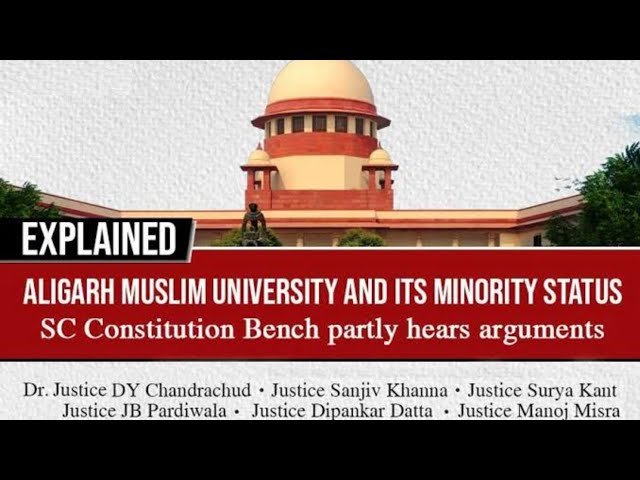Supreme Court Overturns 1967 Ruling on AMU’s Minority Status
In a landmark judgment, the Supreme Court of India recently overturned its 1967 ruling regarding the minority status of Aligarh Muslim University (AMU). This decision is pivotal for the educational and legal landscape of India, as it alters the interpretation of the constitutional provisions surrounding minority institutions. The 1967 judgment had declared that AMU, despite being founded by Muslims, was not a minority institution and could not claim benefits accorded to such institutions. However, the latest Supreme Court verdict has ruled that AMU is indeed a minority institution under Article 30 of the Indian Constitution, which grants minority communities the right to establish and administer educational institutions of their choice.
Supreme Court’s Ruling on AMU
The Supreme Court’s decision to overturn the 1967 ruling has brought attention to the nuances of constitutional interpretation. Article 30 of the Indian Constitution ensures that religious and linguistic minorities have the right to establish and administer educational institutions. In its recent verdict, the court recognized that AMU qualifies as a minority institution, reinforcing the rights of religious minorities to run educational establishments. This judgment will have significant implications on how similar institutions will be treated under Indian law, offering them greater autonomy and the ability to claim certain privileges related to admissions, governance, and financial support.

Why This News is Important
Impact on Minority Rights in Education
The Supreme Court’s decision holds considerable importance in reaffirming the rights of religious minorities to have autonomy over educational institutions. The ruling clarifies the status of AMU, thus encouraging a broader conversation about the rights of other minority institutions in India. For students preparing for exams, especially those aiming for civil services or legal professions, this ruling is significant as it touches upon constitutional law, human rights, and the principle of equality. Understanding this decision is crucial for grasping the delicate balance between the rights of minorities and the regulations governing educational institutions in India.
Legal and Educational Reforms
This judgment will also influence the future of educational reforms in India. It could pave the way for similar educational institutions that are considered minority-run to revisit their status and claim benefits under the constitutional framework. Moreover, it challenges the earlier stance of limiting the benefits of minority status to institutions that were not directly managed or governed by the community. This ruling is an important reference for anyone studying constitutional law, particularly with respect to the rights of minorities.
Historical Context: Background Information on AMU’s Minority Status
Aligarh Muslim University (AMU) has a rich history dating back to its establishment in 1875 as Muhammadan Anglo-Oriental College, with the vision of promoting education among Muslims in India. Founded by Sir Syed Ahmad Khan, the institution became a symbol of modern education for Muslims during the British colonial period. Over the years, AMU has been at the center of discussions about the role of minority educational institutions in India.
In 1967, the Supreme Court had ruled that AMU, despite being founded by Muslims, did not qualify as a minority institution under Article 30. This ruling was significant because it restricted AMU’s ability to seek certain constitutional benefits provided to minority institutions, such as reservation policies and self-governance. However, the recent Supreme Court decision has overruled this, acknowledging the university’s minority status and reinforcing the community’s rights to manage and govern educational institutions. This historical shift highlights the dynamic interpretation of constitutional provisions over time, particularly in the context of evolving societal needs and legal frameworks.
Key Takeaways from “Supreme Court Overturns 1967 Ruling on AMU’s Minority Status”
| Serial Number | Key Takeaway |
|---|---|
| 1 | The Supreme Court has overturned its 1967 ruling, recognizing AMU as a minority institution under Article 30 of the Constitution. |
| 2 | The decision has implications for other religious minority institutions, granting them greater autonomy and rights. |
| 3 | This ruling emphasizes the importance of minority rights in the establishment and governance of educational institutions. |
| 4 | The case highlights a shift in constitutional interpretation regarding minority status for educational institutions. |
| 5 | This judgment is a key reference for civil services aspirants, especially in constitutional law and human rights topics. |
Important FAQs for Students from this News
1. What was the 1967 Supreme Court ruling regarding AMU’s minority status?
In 1967, the Supreme Court ruled that Aligarh Muslim University (AMU) was not a minority institution, despite being founded by Muslims. The ruling prevented AMU from enjoying the benefits granted to minority educational institutions under the Indian Constitution.
2. What does the recent Supreme Court ruling on AMU’s minority status entail?
The recent Supreme Court ruling overturned the 1967 decision, affirming that AMU is indeed a minority institution under Article 30 of the Indian Constitution. This grants AMU the right to run as a minority institution with autonomy in admissions and governance.
3. What is Article 30 of the Indian Constitution?
Article 30 of the Indian Constitution provides religious and linguistic minorities the right to establish and administer educational institutions of their choice. This article ensures that minority institutions can function independently without interference from the state.
4. Why is the Supreme Court’s ruling on AMU significant for minority institutions in India?
The ruling is significant because it reaffirms the rights of religious minorities to control and manage their educational institutions. It could pave the way for other similar institutions to claim minority status and benefit from the rights guaranteed under the Constitution.
5. What are the implications of this judgment for students and legal professionals?
For students preparing for competitive exams, this ruling is crucial as it touches upon constitutional law, human rights, and the status of minority institutions. Legal professionals should understand its impact on future cases involving minority rights and educational autonomy.
Some Important Current Affairs Links


















 Exciting News!
Exciting News!  Join Our Telegram Channel Now!
Join Our Telegram Channel Now!
 Join our Telegram channel for a thrilling adventure into the world of daily current affairs.
Join our Telegram channel for a thrilling adventure into the world of daily current affairs. 
 Don’t miss out on the latest updates and insights! Click to join now and be part of the knowledge revolution!
Don’t miss out on the latest updates and insights! Click to join now and be part of the knowledge revolution! 
